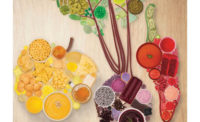2018 Predictions: Colors
Predicted Food Color Technologies for 2018
Color technology advances are a "natural"

Taste the Rainbow. Color suppliers delivering naturally derived, vibrant colors.
SOURCE: GNT USA Inc. (www.gnt-group.com)
A couple of decades ago, blue food seemed to be popping up all over the place. This likely was simply because of the novelty factor. Blue in nature is rare, and in the part of nature that’s edible it is rarer still. Then, açai and the whole anthocyanin “superfruit” trend brought us deep reds and purples. Recently, green drinks came in with a roar, in part triggered by the “add kale to everything” fad.
Although green might be the symbolic color of nature, red is definitely the color of the Back to Nature flag. This has nothing to with leftist politics; natural reds have been at the forefront of the tidal shift from artificial to natural colorings in foods and beverages, pushed ahead to replace the now-spurned Red Dye #40 and bug-derived cochineal colorants.
Further driving vivid reds is the insatiable consumer appetite for red-hot spicy foods. In spite of this rapid transition to natural colorants, one current trend in foods and beverages is what consumers and marketers are calling “unicorn colors.” This refers to the rush of candy, ice cream, and cake products currently hitting the market that use a rainbow of bright primary and secondary colors. But this is more likely a result rather than a cause. Colorant makers have been able to step up technical development fast enough to meet the demand for naturally derived vibrant colors. (Natural sources, such as apples, also are used to make soft, rich browns.)
With blues and greens, look for spirulina and chlorella to pop in the coming year. Although the technology and regulatory hurdles were mostly overcome a few years ago, 2018 will be the year that colors from this recently-perfected algal source become price-competitive. Other contributors to the natural green palette include moringa, hemp, and seaweed, typically in combination with spirulina or turmeric. Also, advanced techniques of manipulating the pH of purples derived from sources such as berries, potatoes, and barley now are used to create true blues.
Vibrant natural reds and oranges also are poised to reflect the technology that has allowed such colors to remain fixed in formulation, without fading, shifting, or bleeding. Plus, the fruits and vegetables providing these colors possess the added benefit of a nutrition and flavor profile that is compatible with, and even enhances, the foods and beverages they brighten. Think: juices, soups, processed meats, and sauces with added antioxidants and carotenoid pro-vitamins.
This could also open the door to using individual carotenoids and anthocyanins rather than extracts and juices of the whole plant. There are hundreds of these compounds covering every conceivable shade of red, orange, yellow, violet, and blue and so could allow for more finely tuned coloring.
While it is too costly to extract such individual compounds, there are ways to manufacture them by fermentation. Only a handful of these individual phytochemicals, predominantly the carotenoids beta-carotene, astaxanthin, lutein and zeaxanthin are currently approved for human consumption.
Similarly, last month the FDA approved the mineral calcium carbonate as a color additive for gum, candies, and similar confections. Also coming soon to a supermarket near you: chameleon-like foods and beverages. Bright and vibrant colors are always in demand, but there is growing interest in color-changing foods and beverages. Colors from natural sources won’t compromise ingredient labels, but they will still provide a color shift when there is a change in pH.
Written by David Feder, RDN, and Matthias Guentert, PhD. Prepared Foods also thanks the following companies for sharing color trend research: GNT USA Inc. (www.gnt-group.com) and Sensient Colors LLC (www.sensientfoodcolors.com).
Originally appeared in the December, 2017 issue of Prepared Foods as In Living Color.
Looking for a reprint of this article?
From high-res PDFs to custom plaques, order your copy today!






